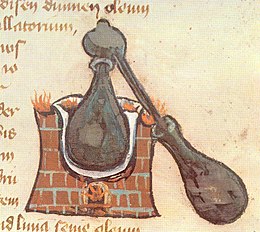Alembic
An alembic (from Arabic: الإنبيق, romanized: al-inbīq, originating from Ancient Greek: ἄμβιξ, romanized: ambix, 'cup, beaker')[1][2][3] is an alchemical still consisting of two vessels connected by a tube, used for distillation of liquids.
Description[edit]
The complete distilling apparatus consists of three parts: the "cucurbit" (Arabic: ḳarʿa; Greek: βῖκος, bîkos), the still pot containing the liquid to be distilled, which is heated by a flame; the "head" or "cap" (إِنْبِيق, ʾinbīq; Greek ἄμβιξ, ambix) which fits over the mouth of the cucurbit to receive the vapors, with an attached downward-sloping "tube" (σωλήν, sōlēn); and the "receiver" (قَابِلَة, qābila; ἄγγος, angos or φιάλη, phialē) container. In the case of another distilling vessel, the retort, the "cap" and the "cucurbit" have been combined to form a single vessel. The anbik is also called the raʾs (head) of the cucurbit. The liquid in the cucurbit is heated or boiled; the vapour rises into the anbik, where it cools by contact with the walls and condenses, running down the spout into the receiver. A modern descendant of the alembic is the pot still, used to produce distilled beverages.
History[edit]
Dioscorides's ambix (described in his De materia medica) is a helmet-shaped lid for gathering condensed mercury. For Athenaeus (≈225 C.E.) it is a bottle or flask. For later chemists it denoted various parts of crude distillation devices.
Alembic drawings appear in works of Cleopatra the Alchemist, Synesius, and Zosimos of Panopolis. There were alembics with two (dibikos) and three (tribikos) receivers.[4] According to Zosimos of Panopolis, the alembic was invented by Mary the Jewess.[5]
The anbik is described by Ibn al-Awwam in his Kitab al-Filaha (Book of Agriculture), where he explains how rose-water is distilled. Amongst others, it is mentioned in the Mafatih al-Ulum (Key of Sciences) of Khwarizmi and the Kitab al-Asrar (Book of Secrets) of al-Razi. Some illustrations occur in the Latin translations of works which are attributed to Geber.[2]
Alembic of Zosimos of Panopolis
Copper retort
Alembic metalwork in the staircase at the Chemical Faculty of Gdańsk University of Technology, 1904
Metaphorical reference[edit]
Metaphorically, an alembic is something that refines as if by distillation.
Unicode[edit]
The Unicode character set specifies three symbols for alembics. The pictograms ⚗, ⚗️, and the ancient alchemical symbol 🝪. The latter is part of the newer UCS-4 addition that includes other ideographs like emojis and thus may not appear correctly on older browsers.
See also[edit]
References[edit]
- ^ M. Ullmann (1986), "AL-KĪMIYĀ", The Encyclopaedia of Islam, vol. 5 (2nd ed.), Brill, p. 111b, ISBN 90-04-07819-3
- ^ a b E. Wiedemann; M. Plessner (1986), "AL-ANBĪḲ", The Encyclopaedia of Islam, vol. 1 (2nd ed.), Brill, p. 486a, ISBN 90-04-08114-3
- ^ Henry Liddell; Robert Scott, eds. (1897), "ἄμβιξ", A Greek–English Lexicon (8th ed.), Harper & Brothers, p. 73
- ^ Marcellin Berthelot (1889), Introduction à l'étude de la chimie des anciens et du moyen âge, Steinheil, pp. 132, 135–142, 161–16
- ^ Edmund Lippmann (1919), Entstehung und Ausbreitung der Alchemie, Springer, pp. 48–49
External links[edit]
 The dictionary definition of alembic at Wiktionary
The dictionary definition of alembic at Wiktionary









No comments:
Post a Comment